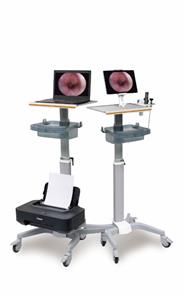Influence of laparoscopic and open radical resection of cervical cancer on pathological results
To investigate the effect of laparoscopic and laparotomy on the pathological results of radical resection of cervical cancer. Methods: A retrospective analysis of 193 patients with cervical squamous cell carcinoma stage IB1-IIA2 who underwent radical resection of cervical cancer who were hospitalized in the Department of Gynecology of Guizhou Provincial Cancer Hospital and the Department of Gynecology of the Affiliated Hospital of Guizhou Medical University from April 2018 to January 2020 were retrospectively analyzed. , including 87 cases of open radical resection of cervical cancer and 106 cases of laparoscopic radical resection of cervical cancer. According to the operation method and postoperative routine pathological results, the differences in pathological results after laparoscopic and open radical resection of cervical cancer were statistically analyzed. The similarities and differences between laparoscopic and open radical resection of cervical cancer, the technical process of pathological diagnosis of cervical cancer in the pathology department were observed and recorded, and the morphology of the histological cells at the incision margin of the pathological tissue by HE staining was observed under the microscope. Results: 1. Comparison between laparoscopic and laparotomy groups: a. General situation: There were 106 cases in the laparoscopic group and 87 in the laparotomy group. The average age of the patients in the laparoscopic group was lower than that in the laparotomy group (47.08±8.99 years old) VS 50.38±10.65 years old, p=0.021), the average length of hospital stay in the laparoscopic group was less than that in the laparotomy group (17.56±6.28 days vs 19.58±4.72 days, p=0.014). b. The number of lymph nodes removed in the laparoscopic group was 23.37±7.04, which was less than 26.78±10.77 in the open group (p=0.012). c. Supplementary radiotherapy and chemotherapy after surgery: 34 cases (34/87, 39.1%) in the laparotomy group were higher than 23 cases (23/87, 21.7%) in the laparoscopy group (p=0.008), and the pathological results indicated high risk factors. There were 24 cases (24/87, 27.6%) in the laparotomy group, 25 cases (25/106, 23.6%) in the laparoscopy group, 47 cases (47/87, 54.0%) in the middle risk group in the laparotomy group, and 49 cases in the laparoscopy group (49/106, 46.2%), the difference between the two groups was not statistically significant (p>0.05), but it can be seen that the proportion of risk factors in the laparotomy group is higher than that in the laparoscopic group. 2. Subgroup analysis: a. IB1 stage: the average hospital stay in the laparoscopic group was 16.42±4.65 days, and the average hospital stay in the laparotomy group was 19.59±4.87 days (p=0.008). group (2.07±1.74cm, 1.10±1.23cm, p=0.016), but the differences in operation time, intraoperative vaginal resection length, lymph node number, risk factors and postoperative radiotherapy and chemotherapy rates were not statistically significant ( p>0.05). b. In stage IIA1, the number of lymph nodes removed during surgery in the two groups was less in the laparoscopic group than in the laparoscopic group (21.70±6.29 VS 26.67±10.96, p=0.02), but the average hospital stay and operation time of the patients in the laparoscopic group were lower than those in the laparoscopic group. , tumor maximum diameter, intraoperative vaginal resection length, risk factors and postoperative radiotherapy and chemotherapy rates were not significantly different (p>0.05). 3.a. To observe the operation process of the two surgical methods, open and laparoscopic radical resection of cervical cancer in the operation steps, surgical resection range is the same, the difference is the use of electrosurgical instruments. b. When the pathologist reads the pathological section, the injury margin is not interpreted, and only the part that can distinguish the cell morphology is used as the margin to interpret whether there is tumor cell infiltration. In this study, we focused on observing the tissue margins that were ignored by pathologists and could not be identified by damage, and observed the changes in the morphology of HE stained cells to judge the degree of damage. c. Collect 10 cases of surgically excised main ligament or teres ligament incision margins from two groups, observe under microscope: Laparoscopic use of electrosurgical instruments to remove tissue margins showed pathological changes in thermally damaged tissue, with a depth range of about 3.5 -7.2mm, the average is 5.46mm. However, although there was no tissue thermal damage under the tissue microscope using the cold knife incision, the cell damage was visible in the vascular clamp part, and the damage depth ranged from 2.0 to 4.6 mm, with an average value of 3.7 mm. The maximum depth of thermal injury in the surgical instrument resection margin tissue was 2.6-5.2mm, and the average was 3.88mm. Among the patients undergoing radical resection of cervical cancer by two surgical methods, the rate of postoperative radiotherapy and chemotherapy in the laparotomy group was higher than that in the laparoscopic group. The infiltration depth of Daliying tumor cells was greater than that in the laparotomy group, which led to an increase in the ratio of postoperative radiotherapy and chemotherapy, but the postoperative radiotherapy and chemotherapy rate in the laparotomy group was higher than that in the laparoscopic group. Excessive coagulation tissue during the process affects the actual interpretation of the surgical margin tissue, leading to false negative pathological results. Conclusion: 1. From the observation of the data in this group, it is concluded that the postoperative radiotherapy and chemotherapy in the laparotomy group is higher than that in the laparoscopic group, considering that the laparoscopy and laparotomy have an impact on the tissue resection margin due to the different surgical instruments and thus affect the judgment of the pathological results. 2. The survival rate of laparoscopic radical resection of cervical cancer is lower than that of laparotomy group. It is necessary to collect more data to confirm whether it is because the different surgical instruments affect the judgment of pathological results and lead to postoperative supplementary treatment.




